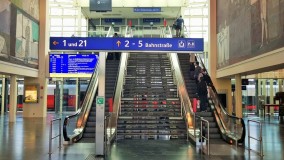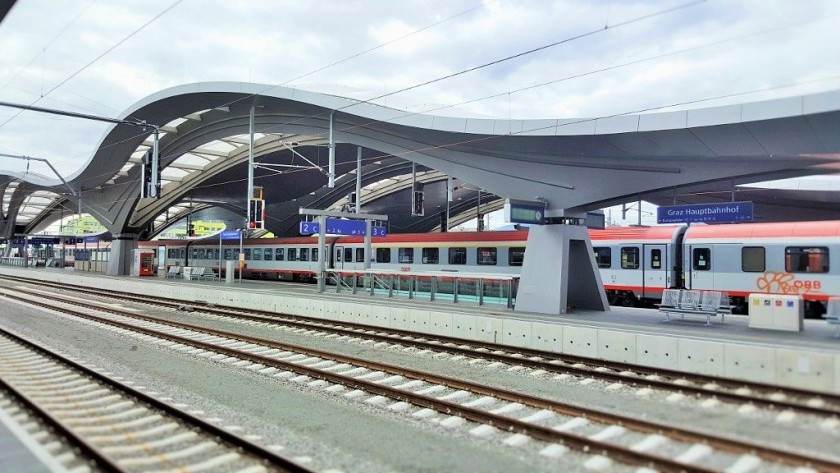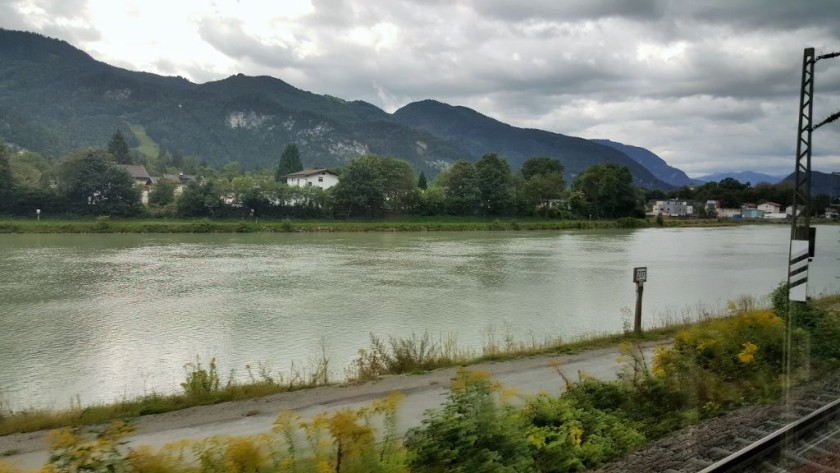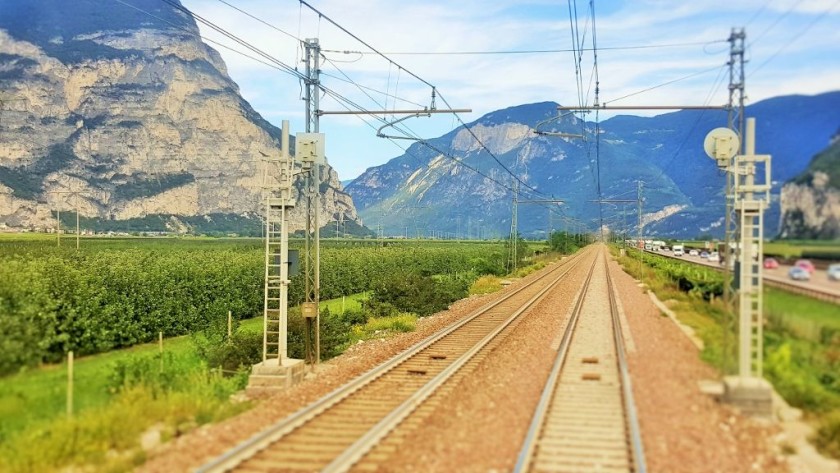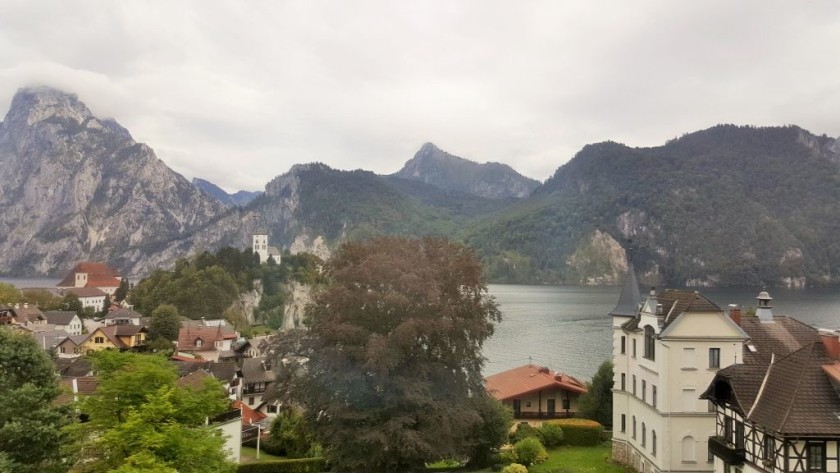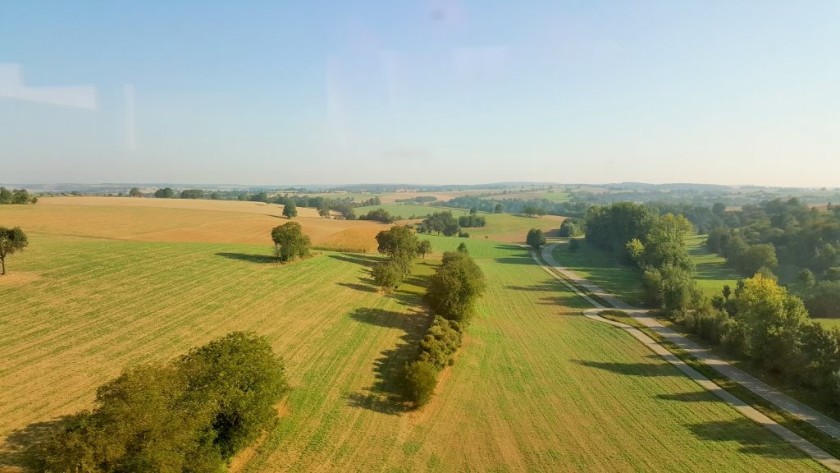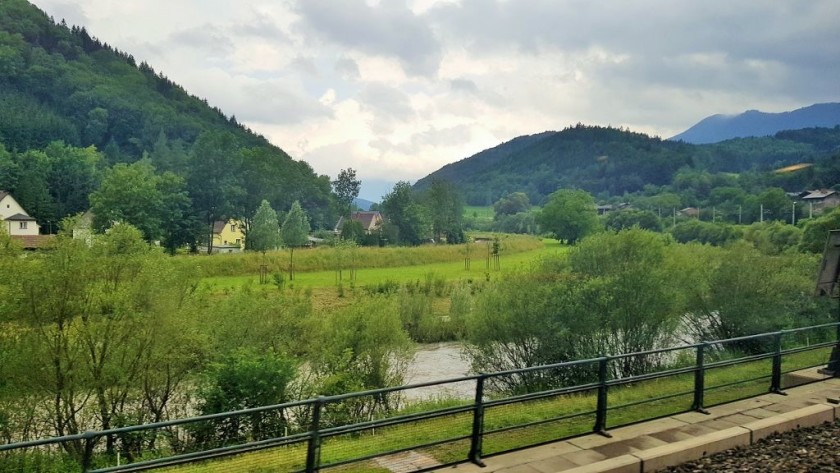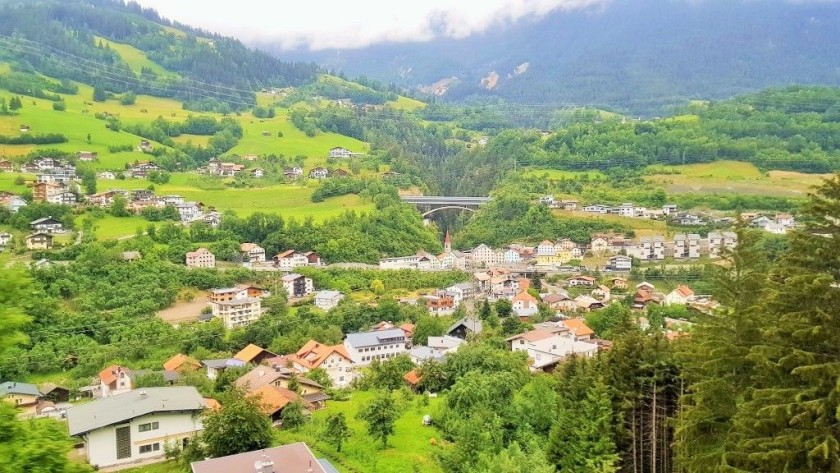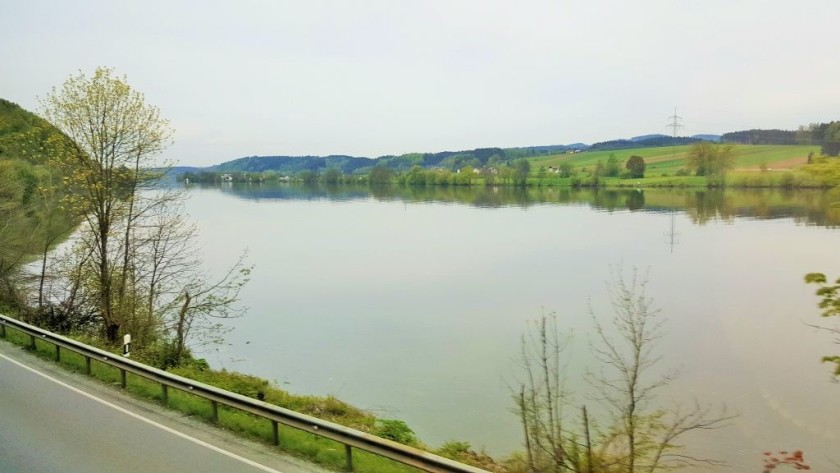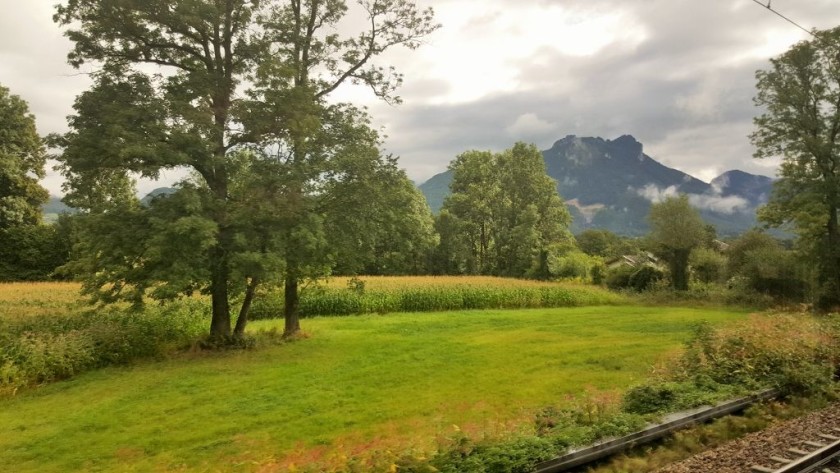Related Content
Content

Austria
Welcome to our guide how to save money, time and confusion when travelling in and from/to Austria by train.
Share
Introducing Austrian rail travel:
Travelling by train in Austria is generally a joy!
On the majority of journeys you’ll be passing through stunning scenery and most of the stations look as though they were built or modernized yesterday.
Also the ticketing and trains are comparatively uncomplicated; though something to keep in mind that all travellers will need a form of photo identification with them such as I.D. cards or passports, so remember to have them with you even when making a rail jouney solely within Austria.
Temporary Covid 19 alterations:
The Austrian national operator OBB has a Covid-19 update page, but the key piece of info is that its mandatory for mouths and noses to be covered with FFP2 mouth and nose protection on OBB's trains, buses and in stations.
Though OBB's usual national timetable is now operating with a full catering service available on the Railjet trains.
The temporary conditions that need to be met in order to enter Austria can be looked up here.
International services to and from Austria:
Almost all* daytime services have resumed on the international rail routes to and from Austria, though restaurant cars aren't open on the sections of the journeys outside Austria; on the EC trains to Italy a catering trolley is being taken through the train instead.
*= The only exception is the EC train to Cluj Napoca in Romania, which remains suspended
All of the Nightjet services have resumed, and the info for meeting the requirements to board and how to travel on these trains is available on OBB's Nightjet travel guide.






Good to know about the trains:
ÖBB is the national operator and it provides the majority of Austrian trains, except for:
(1) some independent scenic mountain railways
(2) the Westbahn trains, which provide alternative services to the ÖBB trains on the Wien/Vienna – Linz – Salzburg route.
ÖBB daytime train services are broadly categorised as:
(1) Railjet Express (RJX): the fastest trains on the Wien/Vienna - Salzburg - Innsbruck - St Anton - Bregenz route
(2) Railjet (RJ): the other express trains between major cities
(3) IC: the less frequent express trains to tourist resorts
(4) REX: the regional trains and the local trains outside the major cities
(5) S-Bahn: the local trains in Austrian cities (not including the Vienna Metro)
ÖBB also operates the Nightjet network, which comprises most, but not all, overnight train services from and to Austria.
The Railjet (RJX and RJ) services from and to Wien/Vienna tend to operate to fixed schedules, departing hourly or every other hour.
Many Railjet routes also extend over the border, so these trains also link Austria to Budapest, Munchen/Munich, Praha/Prague, Venezia/Venice and Zurich.
the Railjets:

The pride of ÖBB are the Railjets which depending on your point of view are either hideously ugly or wonderfully futuristic.
However, what they definitely are is comparatively comfortable, with a wide range of catering options available, including a restaurant service.
Railjets were initially only used on the top tier express routes in Austria, but now the overwhelming majority of express train journeys are by Railjet.
On the main Wien - Linz - Salzburg - (Innsbruck) route some Railjets are faster than others, because they skip more stations; and OBB has now branded these services as 'Railjet - Express'.
On the OBB ticket booking site and on some departure screens at stations, RJX is used to designate these faster trains.
Railjets are also used on international journeys to/from:
- Budapest via Gyor
- Prague/Praha via Breclav (some Railjets on this route are provided by CD, the Czech national rail operator).
- Berlin via Praha and Dresden
- Zurich via Buchs
- Munchen/Munich
- Bratislava
Seats don’t HAVE to be reserved on Railjets and in SMTJ's experience, unless you’re travelling at peak business hours (particularly on Fridays) OR on summer Sunday afternoons, finding a spare seat is unlikely to be a problem.
Reservations are also available, but optional, on the Railjet routes to Czechia, Germany, Hungary, Slovakia and Switzerland, but are mandatory and therefore included when booking tickets for journeys to and from Italy.
the ICE trains:

German ICE-T trains can also be used to travel between Wien/Vienna and Wels via Linz; a route they share with Railjet and Westbahn trains.
They are deployed on these routes between Austria and Germany:
(1) Wien – Linz – Nurnberg – Wurzburg – Frankfurt – Koln
(2) Wien – Linz – Nurnberg – Wurzburg – Kassel - Hannover - Hamburg (1 x train per day)
(3) Wien - Linz - Nurnberg - Erfurt - Halle - Berlin (1 x train per day)
Reservations are optional, but highly recommended when travelling on these ICE trains.
the EC and IC trains:

IC trains are more typical of standard, but comfortable, European express trains, and prior to the arrival of the Railjets, they were the top tier trains on ÖBB.
Though these IC train services are becoming quite rare, because on many routes and services, they have been replaced by Railjets in recent years.
They are now mainly used on less frequent services; some tourist destinations have only one or two direct trains per day from Wien/Vienna and IC trains are used on these services.
Austrian IC coaches are also used for the international EC (EuroCity) trains on these routes:
(1) Munchen - Innsbruck – Bolzano – Verona – Bologna/Venezia
(2) Munchen – Salzburg – Villach – Ljubljana – Zagreb
(3) Wien – Graz – Maribor - Ljubljana and Zagreb
Reservations are compulsory when travelling to Croatia, Italy, Poland and Slovenia.
the non express trains:
Non express trains operated by ÖBB have differing categories depending if they operate in big cities or not.
Longer distance regional trains and the local trains are branded 'REX'.
Local trains to and from the larger cities are the S-Bahn services.
1st class is not usually available on REX trains or local trains, including the S-Bahn trains.
Westbahn's trains:
Trains operated by Westbahn compete with OBB's Railjet trains, in both drections on the Wien - Linz - Salzburg route.
The Nightjets:

Nightjet trains are operated by Austria’s national rail company, OBB, and it sets a specific and consistent standard of service for these trains on its domestic and international routes.
All international Nightjet trains convey compartment seats, couchettes, standard sleeping cabins (no showers) and deluxe sleeping cabins (with showers).
Nightjets also have a dedicated section on the OBB website.
Tips for using the stations:
Five Things that are good to know when using the main stations in Austria:
1. Austria’s major stations (the hauptbahnhofs) including those in Graz, Innsbruck, Linz, Salzburg and Wien/Vienna are comparatively simple to use.
They all follow a similar pattern of having underground passages that are located beneath the tracks that give access to the trains above.
There are always lifts and escalators, which connect the bahnsteigs (platforms/tracks) that the trains arrive at/depart from, with these passage ways.
You never HAVE to use the stairs at a hauptbahnhof (major station) to access the trains.
2. The signage at OBB’s stations is bi-lingual, it is in English and German, but the announcements will be in German only.
3. Announcements are generally made to alert travellers to something out of the ordinary, such as delays
If you think the announcement may be referring to your train watch the departure screens closely.
Particularly pay attention to any scrolling text to the right of the ‘nach’ column, which shows the train’s final destination.
The English translation should follow the German text, so you may need patience to find out what you need to know.
4. The major stations don’t have paper departure sheets, so you have to depend on the electronic departure screens.
Though at busy times the smaller screens will only show trains departing in around the next 25 mins.
5. If you will be changing trains at a hauptbahnhof (major station) there will be blue electronic departure summary screens on the bahnsteig (platform/track).
Though if you will be changing trains and can’t see your next train on this departure screen, the best option is usually to make your way to the main departure hall and wait there for the details of your next train to be confirmed.
You may then need to re-trace your steps, but you can often avoid this if you will be travelling on a Railljet, IC train, or on some EC trains.
While you're on the train, check the paper guide to the departure you’re travelling by, which you should find by your seat.
It will list the details of connections from your train, including the number of the bahnsteig (platform/track) which your next train SHOULD be departing from.
Making your way to the train:
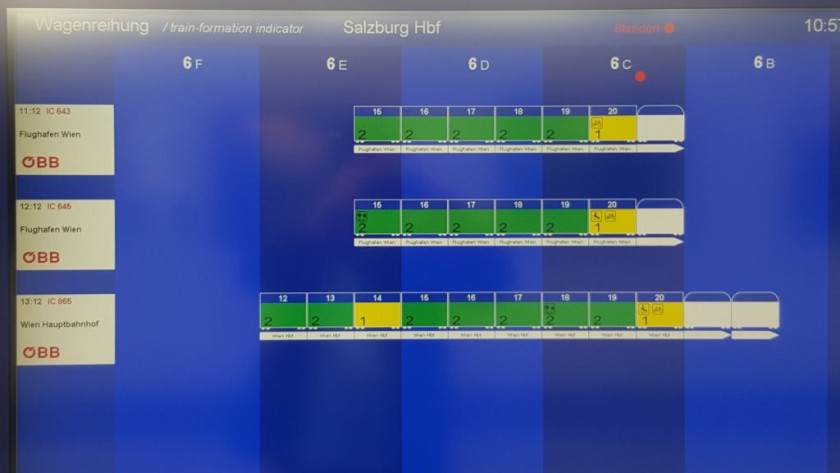

It's worth being aware of these six steps:
1. When looking at the main departure screens ‘Abfarht’ = departures and ‘Ankunft’ = arrivals
2. The bahnsteigs (platforms/tracks) at the hauptbahnhofs (major stations) are divided into zones - A to E.
Most trains only occupy some of these zones, they tend to be shorter than the bahnsteigs (platforms/tracks).
3. On the blue departure screens, small and large, the NUMBER of the bahnsteig (platform/track) will be listed to the right, of the list of stations that the train will be calling at.
To the right of this ‘bahnsteig’ number will be some letters and these letters are the zones on the bahnsteig (platform/track) where the train will depart from.
4. When you arrive on the bahnsteig you will see other blue screens; from a distance they look similar to the smaller version of the departure screens, but they show different information.
Those screens show the ‘Wagenreihung’, which are the formations of the next three trains to depart from the bahnsteig (platform/track).
They indicate which zone each specific coach of a train will occupy when it arrives.
So they’re very useful for working out in which zone you should wait for 1st class, or for a specific coach/wagen where a reserved seat will be located.
5. The departure indicators on the bahnsteigs (platforms/tracks) can show the details of arriving trains.
So don't be surprised if you don't initially see the details of the train you will be taking.
6. If you have a reservation or a Sparschiene ticket it will have a Zug (train) number on it; a four digit number beneath the departure date and time.
This number will also be shown in the ‘Zug’ column on the blue departure screens.
If you will be taking an international train and aren’t sure of its final destination, you may need to rely on this ‘Zug’ number to work out which bahnsteig (platform/track) your train will be leaving from.
The stations that international trains call at can be omitted from the departure screens, but you can use the ‘Zug’ number to find your train.




Top 8 scenic mainline journeys:
- Salzburg <> Villach via Bad Gastein
- Innsbruck <> Brennero
- Wiener Neustadt <> Villach via Klagenfurt
- Felkirch <> Innsbruck
- Innsbruck - Jenbach - Zell am See - Stainach-Irdning - Leoben - Graz
- Wiener Neustadt <> Graz
- Attnang-Puccheim - Hallsat - Bad Ischl - Stainach-Irdning
- Innsbruck <> Mittenwald




Notes on the ticketing:
Tickets are available on OBB up to 6 months ahead of the travel date, but the discounted ‘Sparschiene’ tickets may not be available so far in advance, or made available on every departure on the route you will be taking.
When booking train tickets on OBB for journeys within and to/from Austria, the specific departure you will be taking and the date/day of the week you will be travelling, can matter more to the ticket prices, than how far in advance you will be booking.
When looking up journeys the only price you will initially see is the cheapest 2nd class price per departure.
You need to click on this 2nd class price in order to access a range of upgrades, which include;
- 1st class tickets
- Seat reservations
- Adding 'highest flexibility' to your booking - do that and your ticket won't be tied to a specific departure and will be able to claim a refund if you subsequently alter your travel plans.
Discounted 'Sparschiene' tickets;
The discounted tickets for journeys by RJX, RJ and IC train services and on international trains from Austria are branded as ‘Sparschiene’ tickets and these tickets can ONLY BE BOOKED online or on the OBB app.
They're usually available from 6 months ahead of the travel date, but note that they can't be booked at all at stations.
The price of ‘Sparschiene’ tickets can increase depending on how popular a departure is, the limited numbers at the very cheapest prices will inevitably sell quickly.
So it can be a good idea to search through departures to find the cheapest fares - particularly when travelling between Wien/Vienna and both Salzburg and Innsbruck.
Note the restrictions when booking Sparschiene’ tickets; both 1st AND 2nd class.
These tickets will be specific to the departure you selected when making a booking AND can't be refunded at all if YOU subsequently change your travel plans.
They also can't be exchanged to alternative, later departures.
Reservations:
Seat reservations are optional on RJX, RJ and IC train services, but are not available on REX trains.
Reservations are compulsory when travelling to Croatia, Italy, Poland and Slovenia.
Seats don’t HAVE to be reserved on Railjets or IC trains.
Unless you’re travelling at peak business hours (particularly on Fridays) OR on summer Sunday afternoons - finding a spare seat is unlikely to be a problem.
Though for peace of mind, you can opt to pay a reservation fee on Railjets and ICs when booking online.
Child tickets:
On the OBB trains children aged 5 and under travel for free Children aged 6 – 14 travel at half-fare, except when travelling with adults who have booked Sparschiene tickets - when up to four children can travel at no charge.
Bicycles:
You can’t just hop on a train with your bike in Austria.
To travel by regional REX trains you will need to purchase a special bicycle ticket, which costs 10% of the full price 2nd class ticket; a minimum fee of €2 applies.
For journeys by Railjet trains; IC trains and on international EC trains within Austria, you will need to reserve a space for your bike prior to boarding; the reservation fee for bikes on these trains is €3.50.
More info about how to book these bicycle tickets is available here.
Help with booking train tickets
The super smart and useful ÖBB website also has its quirks
Practical travel guides which feature Austria:
Practical info which will help ease the journeys
Inspirational travel guides which feature Austria:
International rail routes from Austria
Austria is second only to Germany on the 'which country in Europe has the most international trains' list; so there are plenty of options for travelling to and from the country by train.
Even better news, if you'll be exploring Europe with Eurail or InterRail passes, is that comparatively few of these daytime trains have rail pass reservation fees ;though that's partially because Austria isn't served by any international high speed lines.
And the relatively new and ever expanding Nightjet network means that Austria has more international overnight trains than any other country in Europe.
to Czechia (and Poland & Belarus & overnight to Berlin)
rains from Austria to The Czech Republic take one of three routes:
via Breclav:
This is the route taken by the express trains from Wien/Vienna to Czechia – and beyond into Poland and Belarus.
Six different train services come this way:
(1) Railjets which every two hours take a Graz – Bruck an der Mur – Wiener Neustadt – Wien – Breclav – Brno – Pardubice – Prag/Praha route.
One of these trains now continue beyond Prag/Praha to Berlin via Decin and Dresden.
(2) Regiojet trains which take the same route between Wien/Vienna and Prag/Praha.
(3) EC trains on the Wien – Breclav – Brno – Ostrava – Katowice – Warszawa – (Gdasnk – Gydina) route.
1 x train to Gydnia; 1 x train to Warszawa and 1 x train to Katowice.
The train terminating in Warszawa commences its journey in Graz.
(4) A daily EC train which follows a Graz - Wien - Breclav – Brno – Ostrava – Katowice - Krakow - Rzeszow - Przyemysl route.
This is a new service which now provides a direct rail link from Graz to Krakow, and from both Graz and Wien/Vienna to Rzeszow and Przyemysl.
(5) A Euronight train which travels overnight to Warszawa via Krakow.
(6) The Nightjet train from Wien/Vienna to Berlin via Wroclaw in Poland (which takes a different route to the daytime ICE train between the two capitals; see below).
via Gmund:
In even hours during the day, REX trains depart from Franz-Josefs station in Wien/Vienna and travel on this route via Gmund, crossing the border to terminate in the Czech town, Cezke Velenice.
At Ceske Velenice connections are available into trains on to Ceske Budejovice.
via Summerau:
This is a border crossing to have benefited from a significant increase in train services in recent years.
Eight trains per day, which are operated by the CD, the Czech national rail company, travel from Linz to Ceske Budejovice – where connections are available to Plzen.
Four of these trains from Linz have their journeys extended beyond Ceske Budejovice to Praha/Prag.
to Germany (and The Netherlands & now Belgium)
rains from Austria to Germany take one of FIVE primary routes.
Bregenz > Lindau:

The charming towns of Bregenz in Austria and Lindau in Germany on the shore of the Bodensee are connected by frequent local trains which travel along the shore of the lake.
Bregenz is served by express Railjet trains which take a Wien/Vienna – Linz – Salzburg – Innsbruck – Feldkirch – Bregenz route.
However, Feldkirch has more frequent trains from these cities to the east and it is also served by Railjets that have travelled from Zurich via Buchs.
An hourly REX train service provides a direct link between Feldkirch and Lindau via Bregenz, so there's no need to target the trains heading to Bregenz.
Three primary long distance services head from Lindau on into Germany:
(1) to Munchen/Munich via Memmingen
(2) to Munchen/Munich via Kempten
(3) to Ulm via Friedrichshafen (connect in Friedrichshafen for Radolfzell, Singen, Schaffhausen and Basel)
Though if you time it right, you don’t have to change trains in Bregenz and/or Lindau, because TWO international direct routes ALSO pass through these towns.
(1) 6 x EC trains trains per day, which have commenced their journeys in Zurich, link Bregenz directly with Munchen/Munich.
(2) A daily German IC train takes an Innsbruck – St Anton – Feldkirch – Bregenz – Lindau – Ulm – Stuttgart – Mannheim – Mainz – Koblenz – Koln/Cologne – Dusseldorf route.
Seefeld > Mittenwald:
Every other hour regional REX trains depart on the scenic Innsbruck – Seefeld – Mittenwald – Garmisch-Parternkirchen route.
Up to five of these trains per day have their journeys extended beyond Garmisch-Parternkirchen to Munchen/Munich – but in the hours when there are no direct trains, the connections in Garmisch-Parternkirchen should be straightforward.
Though the EuroCity trains from Innsbruck (see below) are faster and will also be cheaper if you book in advance.
Kufstein > Rosenheim:
The only daytime trains which travel over this border crosssing are the 7 x EC trains per day which take an Innsbruck – Jenbach – Worgl – Kufstein – Munchen/Munich route.
During the day these trains depart Innsbruck in even hours.
ICE trains from Munich/Munchen provide the opportunity to travel on to every other major city in Germany.
This is also the route of the nightly Nightjet train from Innsbruck to Hamburg via Hannover and the Nightjet train from Innsbruck to Koln/Cologne which now continues on to Amsterdam via Dusseldorf, Arnhem and Utrecht.
On Saturdays only between December 20th and March 13th, the Alpen Express takes this route - this overnight train connects multiple Austrian ski resorts with Koln/Cologne and these Dutch cities; Amsterdam, Den Bosch, Den Haag, Eindhoven, Haarlem, Leiden, Utrecht and Venlo.
Salzburg > Freilassing:
SEVEN different train services, take this route, as this is the border crossing taken by the many trains that connect Salzburg to Munchen/Munich (a train journey between the two cities takes less than two hours).
(1) Railjet trains which depart every other hour on the Wien/Vienna – Linz – Salzburg – Munchen/Munich Hbf route.
Connect in Munich for ICE trains to multiple destinations including Frankfurt (Main), Hamburg, Koln/Cologne, Nurnberg and Stuttgart.
(2) Railjet trains on the Klagenfurt - Villach – Bad Gastein – Salzburg – Munchen/Munich route (as seen below EC trains also take this route).
(3) EC trains which depart daily on these five routes - and provide direct rail links from locations in Austria to destinations in Germany that are north of Munchen/Munich:
- Klagenfurt - Villach – Bad Gastein – Salzburg – Munchen/Munich – Augsburg – Ulm – Stuttgart – Heidelberg – Frankfurt (Main)
- Klagenfurt - Villach – Bad Gastein – Salzburg – Munchen/Munich – Augsburg – Ulm – Stuttgart – Mannheim – Mainz – Koblenz – Bonn Koln/Cologne – Dusseldorf – Duisburg - Munster
- Salzburg – Munchen/Munich – Augsburg – Ulm – Stuttgart – Karlsruhe
- Graz – Salzburg – Munchen/Munich – Augsburg – Ulm – Stuttgart – Heidelberg – Frankfurt (Main)
- Graz – Salzburg – Munchen/Munich – Augsburg – Ulm – Stuttgart – Mannheim – Kaiserslautern – Saarbrucken
All of these EC trains call at both Munchen Ost and Munchen Hbf stations.
If your final destination is in Munchen/Munich city centre, the quickest end-to-end train journey option is to connect at Munchen Ost station into frequent S-Bahn trains to central Munich.
(4) Hourly regional trains, operated by Meridian, which link Salzburg with Munchen Ost and Munchen Hbf.
(5) Hourly local trains also shuttle across the border on a Salzburg - Freilassing – Bad Reichenhall route.
(6) The Euronight train to Munchen/Munich from Budapest which provides the overnight service to Bavaria from Wien/Vienna
(7) The Euronight train from Zagreb to Munchen/Munich, which travels through Austria in the middle of the night, but it calls in Villach at around 23:20.
Wels > Passau:
The ICE trains from Austria to Germany are the express trains which make this border crossing.
Every other hour during the day they all follow this route Wien/Vienna – Linz – Wels – Passau – Regensburg – Nurnberg, but on departure from Nurnberg they take three different routes, depending on what time the train leaves the Austrian capital.
(1) to Wurzburg – Frankfurt (Main) (with 2 x trains per day continuing beyond Frankfurt (Main) to Frankfurt Flughafen/Airport Mainz – Koblenz – Bonn – Koln/Cologne)
Connect in Frankfurt (Main) for Bruxelles and for Amsterdam and for Paris.
(2) to Wurzburg – Kassel – Hannover – Hamburg (1 x train per day)
(3) to Erfurt – Halle – Berlin (1 x train per day)
The other direct daily daytime train between the Austrian and German capitals takes a route via Prague and Dresden.
This route is also taken by the Nightjet trains on TWO routes from Wien/Vienna and Linz to:
(1) Hamburg via Hannover
(2) Amsterdam via Koln/Cologne
On Tuesdays, Thursdays and Sundays this train also goes to Bruxelles via Liege; the only direct train service from the Austrian capital to the Belgian capital.
In most hours regional Austrian trains also shuttle between Wels and Passau, for connections on towards Regensburg and Nurnberg.
to Hungary and Romania & Ukraine (& Serbia)
Most trains from Austria to Hungary take one of three primary routes.
via Hegyeshalom:
The long-distance day and night trains from Wien/Vienna to Budapest and beyond into Romania, Ukraine (and Serbia) take this border crossing.
They can be categorised as:
(1) Railjets which, every other hour, take this route; Salzburg – Linz – St Polten – Wien Hbf – Gyor – Budapest (Kelenfold) – Budapest Keleti
One Railjet per day to Hungary commences its journey in Switzerland, so also calls at Feldkirch, St Anton and Innsbruck on route to Budapest.
(2) During the day in the hours when no Railjet to Hungary is scheduled to depart, Hungarian 'D' trains also take the Wien Hbf – Gyor – Budapest (Kelenfold) – Budapest (Keleti) route.
(3) A daily EC train USUALLY takes this route; Wien - Gyor – Budapest (Kelenfold) –Budapest (Keleti) – Kelebia – Subotica – Novi Sad – Beograd/Belgrade.
This train service has been suspended until a yet to be confirmed date, due to construction works on the railway line in Serbia, a substitute train service is operating between Budapest and Novi Sad in Serbia, with bus connections on to Beograd
Seperate tickets will be required for the bus services.
(4) A daily Hungarian train, named the 'Transalvania' departs Wien/Vienna at 10:42 and takes this route to Romania - Wien Hbf - Budapest (Keleti) - Szolnok - Oradea - Cluj Napoca, which is the unofficial capital city of Transylvania, hence the name of this train.
this train remains suspended due to the pandemic
(5) The overnight train from Wien/Vienna to Buccresti/Bucharest, which is the only train service from the Austrian capital to the Romanian capital - it also calls in Arad and Brasov.
From June 5th to Oct 5th, there is the opportunity to connect in Buccuresti/Bucharest for direct trains on to both Istanbul and Sofia,
(Outside of those dates there is you can travel to Istanbul via Ruse and Sofia)
This is the simplest route route for a Wien/Vienna to Istanbul train journey.
The first stage of the year round Vienna to Athens train journey involves taking this train to Buccuresti.
the overnight trains on to Athens and Istanbul remain suspended due to the pandemic
(6) A daily train which departs Wien at 16:42 and travels beyond Budapest to call at cities in eastern Hungary, including Debrecen and Zahony - it also conveys sleeping cars heading on to the Ukrainian cities of Lviv and Kiev/Kviv.
(7) A couple of regional trains per day travel from Wien/Vienna to Gyor.
via Sopron:
On Monday – Friday* hourly regional trains depart Wiener-Neustadt for Sopron – the journey between the two cities only takes around 40mins.
Wiener Neustadt is served by comparatively frequent trains from Wien/Vienna and you can connect in Sopron for trains to Szombathely.
*Less frequent trains take this route at weekends.
via Szentgotthard:
Up to seven local trains per day from Graz have their journeys extended over the border so that they terminate in Szentgotthard – then at Szentgotthard connections are available on to Szombathely.
to Italy




via Brennero:

Three different train services now travel on this spectacular route through the Brenner Pass.
(1) Five EC trains per day, which will have commenced their journeys in Munchen/Munich, take this route:
Kufstein – Worgl – Jenbach – Innsbruck – Brennero – Bolzano – Fortezza – Bolzano – Trento – Roverta - Verona.
Connect in Verona for cities to the west including Brescia, Desenzano for Lake Garda, Milano and Torino/Turin.
On Monday- Friday three* of these trains have their journeys extended beyond Verona to Bologna – and at the height of summer, one train continues beyond to Bologna to Rimini.
*Two trains at weekends.
Connect in Bologna for cities further south including Ancona, Bari, Firenze/Florence, Napoli and Roma.
On Monday – Friday one* of these trains continues beyond Verona to call at Vicenza, Padova/Padua and Venezia/Venice.
*Two trains at weekends.
(2) A daily Railjet train which departs from Wien/Vienna at 15:30 and calls in both Linz at 16:44 and Salzburg at 17:52 and travels on via Innsbruck, Brennero and Fortezza to terminate in Bolzano.
(3) Hourly local S-Bahn trains depart Innsbruck for Brennero
In Brennero they make connections with Italian trains heading south to Merano** via Bolzano OR trains heading south to Bologna via Bolzano, Trento and Verona
So if you'll be using an InterRail or Eurail pass and want to avoid the rail pass reservation fees, when travelling from Austria to Italy, you can target these trains.
**These trains to Merano are not operated by Trenitalia, so rail passes are NOT valid on these trains.
via San Candido:
On Monday – Friday* hourly trains travel from Lienz to Fortezza, where connections are available into trains heading south to Bologna, Bolzano, Venezia and Verona.
*The service is less frequent at weekends.
Lienz has a sporadic service of S-Bahn trains from Klagenfurt via Villach.
There is also a daily IC train which departs Vienna/Wien Hbf for Lienz at 08:25, this train then makes a connection into a train on to Fortezza, which then makes a connection into a Regionale Veloce train to Bologna via Bolzano, Trento and Verona.
However, rail pass users travelling this way should note that Trenitalia does not operate the route between San Candido and Fortezza, so rail passes are not valid on this section of the route.
via Tarvisio:
Two Railjet trains per day come this way on the Wien/Vienna – Wiener Neustadt – Bruck an der Mur – Leoben – Klagenfurt – Villach – Tarvisio – Udine (connect for Trieste) – Treviso – Venezia/Venice/Venedigg route.
Connect in Venezia/Venice for frequent trains to other Italian cities including Bologna, Firenze/Florence, Milano, Napoli, Torino/Turin and Verona.
In addition two regional trains per day travel on this part of the route; Villach – Tarvisio – Udine
These trains enable rail pass users to avoid paying any reservation fees on this route.
The Nightjet overnight trains from Austria to Italy on these THREE routes also make this border crossing:
(1) Wien/Vienna – Wiener Neustadt – Bruck an der Mur – Leoben – Klagenfurt – Villach – Padova/Padua – Vicenza – Verona – Peschiera del Garda – Desenzano del Garda – Brescia – Milano
The only direct train from Austria to Milano.
(2) Wien/Vienna – Wiener Neustadt – Bruck an der Mur – Leoben – Klagenfurt – Villach – Bologna – Firenze/Florence – Arezzo – Roma
The only direct train from Austria to Firenze/Florence and Roma.
(3) Wien/Vienna – St Polten – Linz – Salzburg – Tarvisio – Udine – Treviso – Venezia/Venice
to Slovakia
The most frequent train services between Austria and Slovakia are the regional (REX) trains from Wien/Vienna to Bratislava.
They depart hourly from Wien Hbf on two routes, via
- Marchegg, and
- Bruck an der Leitha,
but only the trains via Marchegg arrive at the Bratislava hl.n, the main station in the Slovakian capital.
In addition to these Regional trains, which provide the bulk of the rail service between Europe's two most closely spaced capital cities, there are two daily express trains.
(1) A daily IC train, which is usually scheduled to depart from Wien/Vienna at 14:42, travels beyond Bratislava to Kosice, where it is due to arrive at 20:42; it also calls in Zilina and Poprad Tatry.
(2) A Railjet service to Bratislava, which commences its journey in Zurich and calls at these stations in Austria; Feldkirch – Innsbruck – Salzburg – Linz – St Polten and Wien/Vienna (depart 20:42).
to Slovenia (and Croatia & Serbia & Trieste in Italy):




Trains from Austria to Slovenia take three routes.
via Spielfeld >Straab:
The only express trains which come this way are the daily EC express services on these two wonderfully scenic routes, which connect the Austrian capital to the capital cities of both Croatia and Slovenia.
(1) Wien/Vienna – Wiener Neustadt – Bruck an der Mur – Graz – Maribor – Zidani Most – Ljubljana - Trieste
(2) Wien/Vienna – Wiener Neustadt – Bruck an der Mur – Graz – Maribor – Dobova – Zagreb
Between June 20th and Sept 20th this train connects in Zagreb for an overnight train to Beograd/Belgrade - from where it's possible to travel on to Athina/Athens, or to Sofia and Istanbul.
In addition to these two express trains, there are also hourly local trains which travel between Spielfield StraB and Maribor and these trains have good connections with local trains from Graz to Spielfield StraB.
via Beiburg:
On Monday – Friday* two trains per day now head to Maribor, from the Austrian border town of Bleiburg.
*1 x train per day at weekends.
On Monday-Friday connecting trains should depart Klagenfurt for Bleiburg at 08:05 and 16:35.
Rosenbach > Jesenice:
This is the railway route from southern Austria into Slovenia.
If you want to explore some of the most beautiful European landscapes and cities by train, then worth knowing is that the Austrian city, Villach, is the gateway for train journeys between the Alps and Slovenia; and from Slovenia you can travel on into Croatia and Serbia, and Bulgaria, Greece and Turkey.
the trains on to Greece and Turkey remain suspended due to the pandemic
Local trains used to shuttle between Villach and Jesenice in Slovenia, but now the only option for travelling this way is taking one of these SIX long-distance express trains.
DAY TRAINS:
(1) For those prepared to set the alarm, there is a very early morning train which takes a Schwarzach St Veit (04:25) > Bad Gastein (05:00) > Villach (06:28) > Jesenice > Lesce-Bled (for Lake Bled) > Ljubljana > Zidani Most > Dobova > Zagreb route.
(This train usually travels on to Beograd, but this part of the route is currently suspended)
It is due to arrive in Beograd/Belgrade at 18:07 - and following an overnight stay in Beograd it's possible to travel on to both Athens and Istanbul via Sofia.
(These trains on to Athens and Istanbul remain suspended).
This is usually the only direct train from Austria to Beograd/Belgrade.
An overnight train from Salzburg connects into this train in Zagreb, but it departs from Salzburg at 01:40.
(2) An early afternoon train which commences its journey in Villach and takes a Villach - Jesenice – Lesce-Bled (for Lake Bled) – Ljubljana – Zidani Most – Dobova – Zagreb – Vinkovici route, though it doesn't offer an onward connection from Vinkovici into Serbia.
It has a connecting train which departs from Munchen/Munich at 08:17 and travels via Salzburg (10:12), Schwarzach St Veit and Bad Gastein.
(3) A daily EC (EuroCity) express train which has travelled from Frankfurt (Main) via Munchen/Munich to Austria and takes a Salzburg – Schwarzach St Veit - Bad Gastein - Villach – Jesenice – Lesce-Bled (for Lake Bled) – Ljubljana – Zidani Most – Dobova – Zagreb route.
Thereby providing a direct train from Salzburg to Slovenia and Croatia; connect in Salzburg if you will be setting off from Innsbruck.
Between June 20th and Sep 13th it connects in Zagreb for a train which travels overnight to Beograd, where it arrives at 06:05; it conveys sleeping cars.
Between those dates it's possible to travel on from Beograd by taking the daily train to Sofia and following another overnight stay, there is the option of travelling on to Istanbul by train.
Or take the night train to Thessaloniki in Greece, from where it's possible to travel on to Athina/Athens.
(4) An evening train is scheduled to depart Villach at 18:53 on a Jesenice > Lesce-Bled (for Lake Bled) > Ljubljana > Zidani Most > Dobova route.
Between June 20th and Sep 13th it connects in Ljubljana for that overnight train to Beograd/Belgrade.
This train from Villach has a connection from Salzburg (depart 16:12) via Bad Gastein; and that train (which calls in Salzburg), will usually travel to Austria through Germany and makes calls in Koln (08:17), Mannheim, Stuttgart and Munchen (14:17).
NIGHT TRAINS:
(5) An overnight train to Ljubljana (arrives 08:13) and Zagreb (10;49) commences its journey in Zurich (20:40) and makes calls at multiple stations in western Austria including Feldkirch (22:45); St. Anton (23:45) and Innsbruck (00:56).
It is the only direct train from those cities to Slovenia and Croatia.
On arrival at Schwarzach St Veit the 'daytime' train from there to Beograd/Belgrade is attached to this train, so it offers a guaranteed connection for a train journey from western Austria (and Zurich) to Serbia. this train remains suspended due to the pandemic
Following an overnight stay in Beograd, between June 13th and Sept 20th, it's possible to travel on to Athens, or to Istanbul via Sofia.
(6)The overnight train from Munchen/Munich to Zagreb via Ljubljana departs from Salzburg at 01:40.
to Switzerland




Trains from Austria to Switzerland only take one of two routes.
Feldkirch > Buchs:

The three long-distance services which travel this way are:
(1) The Railljet trains which operate every other hour on the Wien/Vienna > Linz >Salzburg > Innsbruck > St Anton > Feldkirch > Buchs (connect for Chur) > Sargans > Zurich route.
(2) One EC train per day, the 'Transalpin' which takes a Graz > Zell Am See > Kitzbuhel > Innsbruck > St Anton > Feldkirch > Buchs (connect for Chur) > Sargans > Zurich route.
(3) The overnight trains from Graz, Wien/Vienna and Villach to Zurich (the train from Wien will have commenced its journey in Budapest and the train from Villach will have travelled from Zagreb via Ljubljana).
Connect in Zurich for most other Swiss cities including Basel, Bern, Biel, Brig, Geneve, Lausanne, Lugano and Neuchatel.
The only other trains which take this route are the local commuter trains, which shuttle across the border from Feldkirch to Buchs, during the early mornings and late afternoons on Monday to Friday.
Bregenz > St Margrethen:
The only trains which makes this border crossing are the six daily EC trains on the newly improved Munchen/Munchen – Lindau – Bregenz – St Margrethen* - St Gallen –Zurich Flughafen/Airport – Zurich route.
*Connect in St Margrethen for trains to Chur via Landquart.
Trains




















Cities
Graz
Rail Stations
Innsbruck
Rail Stations
Klagenfurt
Rail Stations
Linz
Rail Stations
Salzburg
Rail Stations
Wien / Vienna
Rail Stations
Journeys
# Jump to a cityInnsbruck
Journeys from Innsbruck
Jump to citiesInnsbruck to Bratislava by train
Innsbruck to Brennero/Brenner by train
Innsbruck to Budapest by train
Innsbruck to Garmisch - Partenkirchen by train
Innsbruck to Graz by train
Innsbruck to Hamburg by train
Innsbruck to Hopfgarten im Brixental by train
Innsbruck to Jenbach by train
Innsbruck to Kitzbühel by train
Innsbruck to Köln / Cologne / Koeln by train
Innsbruck to Linz by train
Innsbruck to Mayrhofen by train
Innsbruck to München / Munich by train
Innsbruck to Ötztal / Otzal by train
Innsbruck to Radstadt by train
Innsbruck to Salzburg by train
Innsbruck to Schladming by train
Innsbruck to Seefeld in Tirol by train
Innsbruck to St Johann in Tirol by train
Innsbruck to St. Anton by train
Innsbruck to Stuttgart by train
Innsbruck to Venezia / Venice / Venedig by train
Innsbruck to Verona by train
Innsbruck to Wien / Vienna by train
Innsbruck to Zell am See by train
Innsbruck to Zürich / Zurich by train
Journeys to Innsbruck
Jump to citiesBologna to Innsbruck by train
Budapest to Innsbruck by train
Hamburg to Innsbruck by train
Köln / Cologne / Koeln to Innsbruck by train
München / Munich to Innsbruck by train
Salzburg to Innsbruck by train
Venezia / Venice / Venedig to Innsbruck by train
Verona to Innsbruck by train
Wien / Vienna to Innsbruck by train
Zürich / Zurich to Innsbruck by train
Salzburg
Journeys from Salzburg
Jump to citiesSalzburg to Bad Ischl by train
Salzburg to Bratislava by train
Salzburg to Budapest by train
Salzburg to Frankfurt by train
Salzburg to Graz by train
Salzburg to Hallstatt by train
Salzburg to Heidelberg by train
Salzburg to Hopfgarten im Brixental by train
Salzburg to Innsbruck by train
Salzburg to Jenbach by train
Salzburg to Kitzbühel by train
Salzburg to Klagenfurt by train
Salzburg to Koblenz by train
Salzburg to Köln / Cologne / Koeln by train
Salzburg to Linz by train
Salzburg to Ljubljana by train
Salzburg to Mayrhofen by train
Salzburg to München / Munich by train
Salzburg to Ötztal / Otzal by train
Salzburg to Radstadt by train
Salzburg to Schladming by train
Salzburg to St Johann in Tirol by train
Salzburg to St. Anton by train
Salzburg to Wien / Vienna by train
Salzburg to Zagreb by train
Salzburg to Zell am See by train
Salzburg to Zürich / Zurich by train
Journeys to Salzburg
Jump to citiesBudapest to Salzburg by train
Frankfurt to Salzburg by train
Innsbruck to Salzburg by train
Köln / Cologne / Koeln to Salzburg by train
München / Munich to Salzburg by train
Wien / Vienna to Salzburg by train
Zürich / Zurich to Salzburg by train
Wien / Vienna
Journeys from Wien / Vienna
Jump to citiesWien / Vienna to Bratislava by train
Wien / Vienna to Bregenz by train
Wien / Vienna to Bruxelles / Brussels by train
Wien / Vienna to București / Bucharest by train
Wien / Vienna to Budapest by train
Wien / Vienna to Firenze / Florence by train
Wien / Vienna to Frankfurt by train
Wien / Vienna to Graz by train
Wien / Vienna to Győr / Gyor by train
Wien / Vienna to Hamburg by train
Wien / Vienna to Hannover by train
Wien / Vienna to Innsbruck by train
Wien / Vienna to Klagenfurt by train
Wien / Vienna to Koblenz by train
Wien / Vienna to Köln / Cologne / Koeln by train
Wien / Vienna to Kraków / Krakow / Cracow by train
Wien / Vienna to Linz by train
Wien / Vienna to Ljubljana by train
Wien / Vienna to London by train
Wien / Vienna to Milano / Milan / Mailand by train
Wien / Vienna to München / Munich by train
Wien / Vienna to Nürnberg / Nuremberg by train
Wien / Vienna to Praha / Prague / Prag by train
Wien / Vienna to Roma / Rome by train
Wien / Vienna to Salzburg by train
Wien / Vienna to Semmering by train
Wien / Vienna to St. Anton by train
Wien / Vienna to Venezia / Venice / Venedig by train
Wien / Vienna to Verona by train
Wien / Vienna to Villach by train
Wien / Vienna to Warszawa / Warsaw by train
Wien / Vienna to Zagreb by train
Wien / Vienna to Zürich / Zurich by train
Journeys to Wien / Vienna
Jump to citiesBerlin to Wien / Vienna by train
Bruxelles / Brussels to Wien / Vienna by train
Budapest to Wien / Vienna by train
Firenze / Florence to Wien / Vienna by train
Frankfurt to Wien / Vienna by train
Hamburg to Wien / Vienna by train
Innsbruck to Wien / Vienna by train
Köln / Cologne / Koeln to Wien / Vienna by train
London to Wien / Vienna by train
Milano / Milan / Mailand to Wien / Vienna by train
München / Munich to Wien / Vienna by train
Paris to Wien / Vienna by train
Praha / Prague / Prag to Wien / Vienna by train
Roma / Rome to Wien / Vienna by train
Salzburg to Wien / Vienna by train
Venezia / Venice / Venedig to Wien / Vienna by train
Warszawa / Warsaw to Wien / Vienna by train
Zürich / Zurich to Wien / Vienna by train
See if there’s a unique journey guide for your trip, featuring info on the trains, tickets & stations.

This is one of more than 150 train guides available on ShowMeTheJourney, which will make it easier to take the train journeys you want or need to make. As always, all images were captured on trips taken by ShowMeTheJourney.










